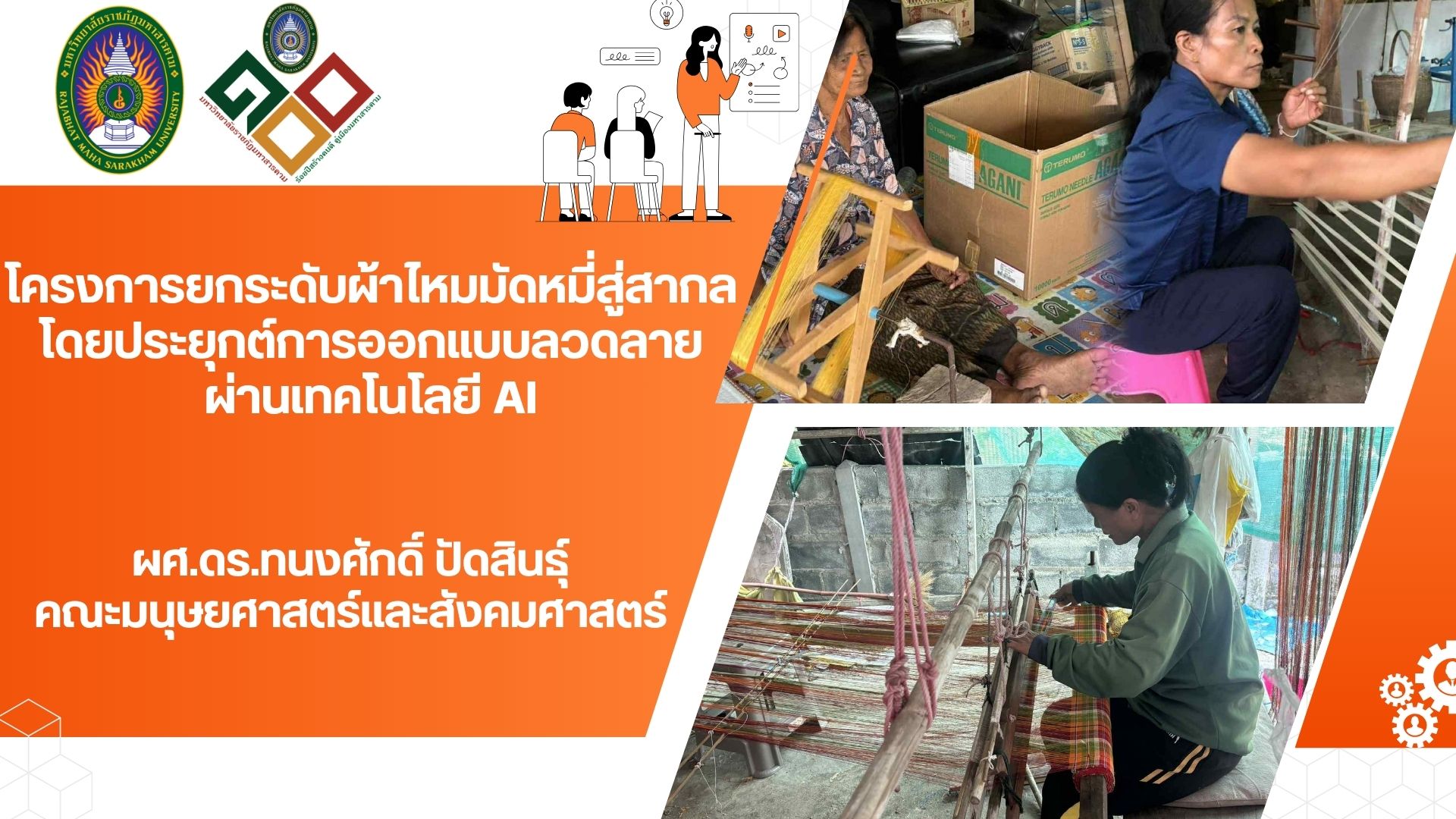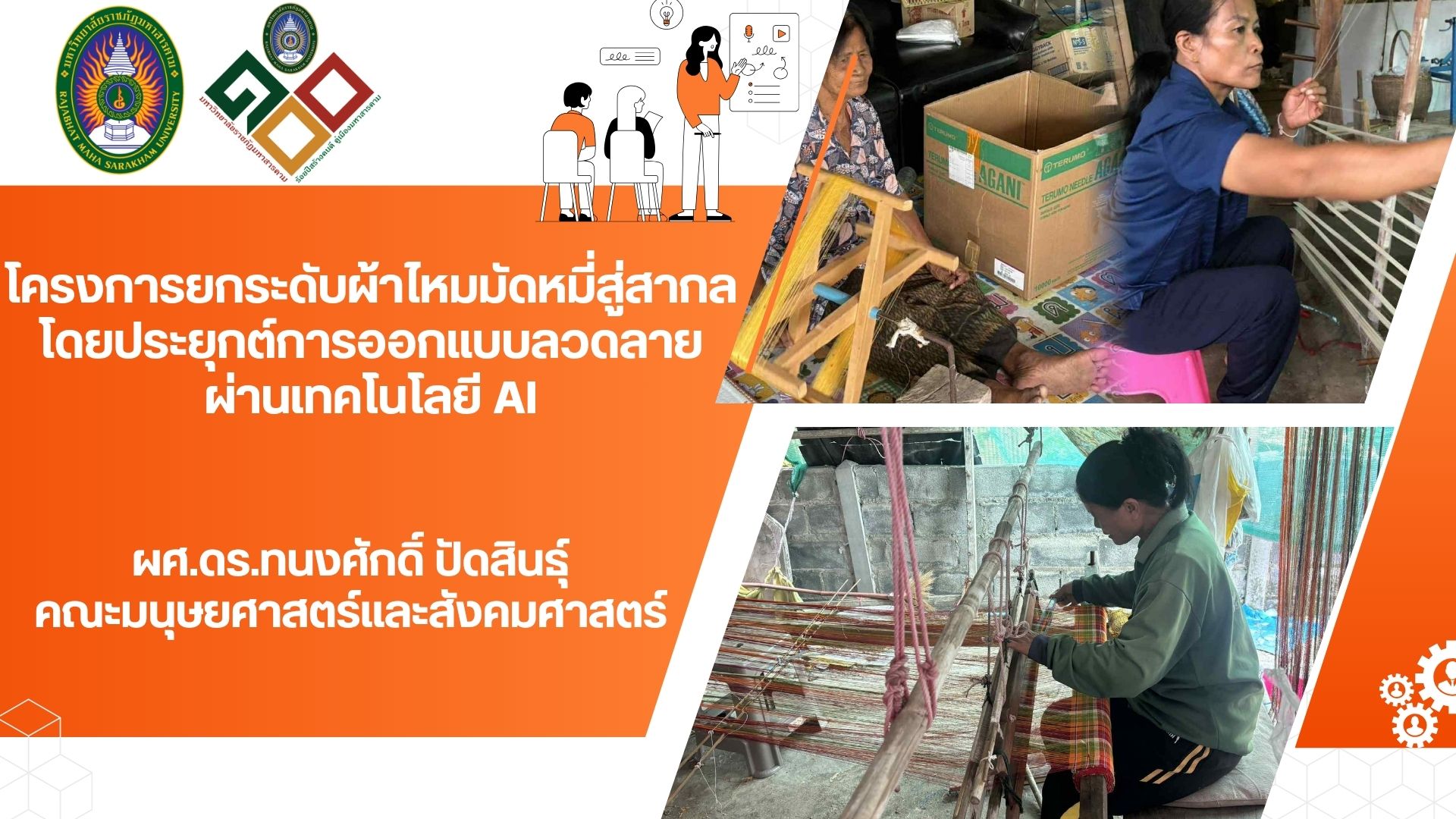
Enhancing Mudmee (IKAT) Silk to the Global Stage through Pattern Design Applied via AI Technology
ผู้รับผิดชอบ ให้ข้อมูล : Asst. Prof. Dr. Thanongsak Padsin
SDG ที่เกี่ยวข้อง
เป้าหมายย่อยความสอดคล้องกับยุทธศาสตร์มหาวิทยาลัย : พันธกิจสัมพันธ์เพื่อการพัฒนาท้องถิ่นอย่างสร้างสรรค
แหล่งงบประมาณ : งบประมาณแผ่นดิน
กลุ่มเป้าหมาย : ชุมชน
Project Implementation Area : Nong Hin Village ตำบล Hua Dong อำเภอ Na Dun จังหวัด Maha Sarakham 44180
Project Duration: October 12, 2024 – September 30, 2025
Objectives :
1. To enhance Mudmee silk and increase its value for the local community.
2. To design Mudmee silk patterns by applying AI technology.
3. To promote the distribution of products through online platforms to the global market to develop the local community’s grassroots economy. economic development
Activities :
Upstream activities: Enhancing Mudmee silk quality and its value for the local community. Midstream activities: Designing Mudmee silk patterns by applying AI technology. Downstream activities:
Promoting the distribution of products through online platforms to the global market, aiming to develop the local community’s grassroots economy.
Number of project participants: 40 people
Project Budget: 270,000 Baht
Results :
- At least one piece of knowledge on enhancing community products.
- At least one innovation applied to daily life in a fair and ethical manner.
- At least one learning process involves entrepreneurs, educational institutions, and community members.
- At least one community benefiting from the application of project results for social and community development.
- At least one community has developed products that are available on online platforms and contribute to community well-being.
- At least 5 Mudmee silk patterns designed by applying AI technology.
- At least one new entrepreneur emerging in the local community.
Results society :
- Economic aspect: Increasing community income by at least 5,000 THB per household per month. The innovation of designing silk patterns based on local identity using computer software (Microsoft Excel) will allow Mudmee silk to fetch higher prices. It also promotes the distribution of Mudmee silk through newly established online marketplaces, focusing on sustainable grassroots economic development in Maha Sarakham Province.
- Social aspect: The innovation of designing silk patterns based on local identity using computer software (Microsoft Excel), implemented collaboratively by researchers, local communities, and government agencies, provides the community with unique and distinctive patterns. This fosters a sense of pride and ownership among community members regarding their Mudmee silk designs.
- Educational aspect: The project to elevate the standards of Mudmee silk products through online platforms, based on community identity, emphasizes participatory learning among universities, communities, government, and private sectors, creating local learning resources.
- Environmental aspect: The dyeing process of Mudmee silk focuses on environmentally friendly methods that do not harm the local ecosystem.
Participation :
Students participate in addressing community issues and provide knowledge on Mudmee silk within the community.
Project continuity :
Mulberry cultivation and silkworm rearing in the community to enable the community to obtain the Mudmee silk product certification: the ‘Royal Peacock Seal’.
Problems obstacles :
- Field visits for project activities.
- Coordination with target groups in the community.
- Conducting training courses on chemical and natural dyeing processes, designing Mudmee silk patterns by applying AI technology, and promoting product distribution through online platforms to the global market to develop the local community’s grassroots economy.
- Extracting lessons learned from the training courses on chemical and natural dyeing processes, AI-applied Mudmee silk pattern design, and online product distribution for sustainable local economic development.
- Returning information and results to Huadong Subdistrict, Nadun District, Maha Sarakham Province.
Improvement :
- Field visits for project activities: The project team coordinated with the Subdistrict Administrative Organization (SAO), Village Health Volunteers (VHVs), and community leaders prior to conducting project activities. Activities were organized in small groups within each community to ensure convenience for target participants.
- Coordination with target groups in the community: The project team worked closely with local teams, which is a key advantage of this project. Since local teams are based in Huadong Subdistrict, coordination was fast and efficient.
- Extracting lessons learned from training courses: The courses included chemical and natural dyeing processes, AI-applied Mudmee silk pattern design, and promotion of product distribution through online platforms for sustainable grassroots economic development. The project team arranged for local teams to gather target participants living nearby into groups for collaborative lessons learned sessions.
- Returning information to the community: The project team provided feedback to representatives of each community in Huadong Subdistrict, Nadun District, Maha Sarakham Province, who then communicated the results to the target participants.
Suggestions :
The university is encouraged to give priority to projects that will be evaluated by external experts.
